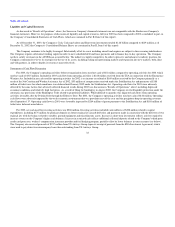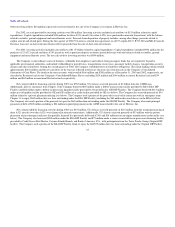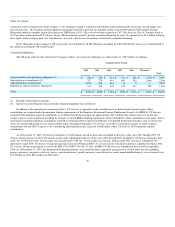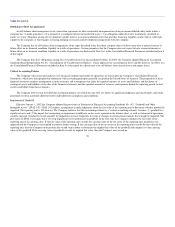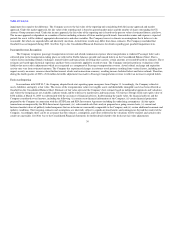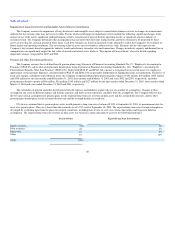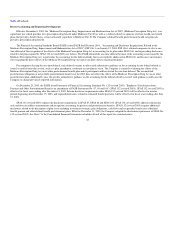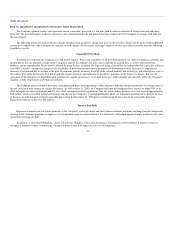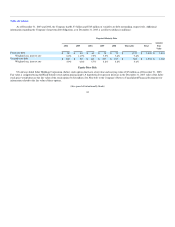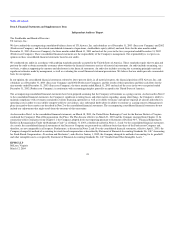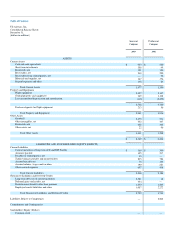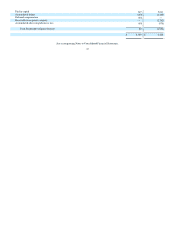US Airways 2003 Annual Report Download - page 43
Download and view the complete annual report
Please find page 43 of the 2003 US Airways annual report below. You can navigate through the pages in the report by either clicking on the pages listed below, or by using the keyword search tool below to find specific information within the annual report.
Table of Contents
Off-Balance Sheet Arrangements
An off-balance sheet arrangement is any transaction, agreement or other contractual arrangement involving an unconsolidated entity under which a
company has (1) made guarantees, (2) a retained or a contingent interest in transferred assets, (3) an obligation under derivative instruments classified as
equity or (4) any obligation arising out of a material variable interest in an unconsolidated entity that provides financing, liquidity, market risk or credit risk
support to the company, or that engages in leasing, hedging or research and development arrangements with the company.
The Company has no off-balance sheet arrangements of the types described in the first three categories that it believes may have a material current or
future effect on its financial condition, liquidity or results of operations. Certain guarantees that the Company does not expect to have a material current or
future effect on its financial condition, liquidity or results of operations are disclosed in Note 8(e) to the Consolidated Financial Statements included in Item 8
of this report.
The Company does have obligations arising out of variable interests in unconsolidated entities. In 2003, the Company adopted Financial Accounting
Standards Board Interpretation No. 46, "Consolidation of Variable Interest Entities," which addresses the accounting for these variable interests. See Note 2 to
the Consolidated Financial Statements included in Item 8 of this report for a discussion of its off-balance sheet aircraft leases and airport leases.
Critical Accounting Policies
The Company's discussion and analysis of its financial condition and results of operations are based upon the Company's Consolidated Financial
Statements, which have been prepared in conformity with accounting principles generally accepted in the United States of America. The preparation of these
financial statements requires management to make estimates and assumptions that affect the reported amounts of assets and liabilities and disclosure of
contingent assets and liabilities at the date of the financial statements and the reported amounts of revenues and expenses during the reporting period. Actual
results could differ from those estimates.
The Company believes that the following accounting policies are critical because they are subject to significant judgments and uncertainties and could
potentially result in materially different results under different assumptions and conditions:
Impairment of Goodwill
Effective January 1, 2002 the Company adopted the provisions of Statement of Financial Accounting Standards No. 142, "Goodwill and Other
Intangible Assets" (SFAS 142). SFAS 142 requires management to make judgments about the fair value of the reporting unit to determine whether goodwill is
impaired. The reporting unit is US Airways. The Company believes that this accounting estimate is a "critical accounting estimate" because: (1) goodwill is a
significant asset and (2) the impact that recognizing an impairment would have on the assets reported on the balance sheet, as well as statement of operations,
could be material. Goodwill is tested annually for impairment or more frequently if events or changes in circumstances indicate that it might be impaired. The
provisions of SFAS 142 require that a two-step impairment test be performed on goodwill. In the first step, the Company compares the fair value of the
reporting unit to its carrying value. If the fair value of the reporting unit exceeds the carrying value of the net assets of the reporting unit, goodwill is not
impaired and the Company is not required to perform further testing. If the carrying value of the net assets of the reporting unit exceeds the fair value of the
reporting unit, then the Company must perform the second step in order to determine the implied fair value of the goodwill and compare it to the carrying
value of the goodwill. If the carrying value of goodwill exceeds its implied fair value, then the Company must record an
38






